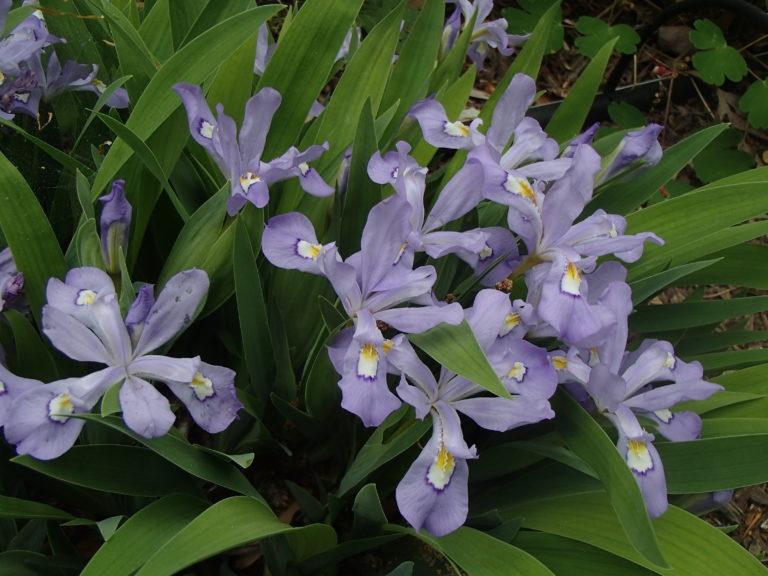Dwarf Crested Iris is beloved in southern gardens as it is a beautiful and easy groundcover. In nature, it is found in rich or rocky wooded slopes and stream banks in Eastern states, well inland from the coast, and in NC is reported in mountain and piedmont counties only. Dwarf Crested Iris is short, the pointy sword-shaped leaves growing only to about six inches tall. It has many handsome, frilly blue-to-lilac-to-white, fragrant iris blooms with gold crests on 4-inch stems in May and June, flowering over a period of a couple of weeks. This beautiful, rapidly spreading, rhizomatous ground cover grows well even in the heat of the summer. Where it occurs on our property (we did not plant it), it thrives on a sunny, well drained slope, though it clearly would appreciate some afternoon shade, or a little more moisture. It is a drift of lovely color. Maintenance consists of removing tree seedlings popping up every now and again, and dividing the plants to thin every 2-3 years. The famous American Quaker botanist, John Bartram, introduced Iris cristata to England, where it has been grown since 1766. European gardeners have enjoyed it ever since.
NURSERY HOURS
Wednesday: 10-4 Thursday: 10-6 Friday-Saturday: 10-4 Sunday: 12-4
Iris cristata Aiton

Key Info
Common Names: Dwarf Crested Iris, Lady's Calamus
Family Names: Iridaceae (Iris Family)
Flower Color: White, shades of blue/purple
Special Characteristics: Attracts bees, Reported to be deer resistant, Attracts Hummingbirds, Rhizomatous, Tolerates drought
Additional Info
Habit: Overlapping, sword-shaped leaves arise directly from thick, whitish rhizomes connected by slender stolons; roots are shallow and fleshy.
Height: 6"
Spread: 15"
Soil Conditions: Moist, well drained; neutral to slightly acidic soils; organic, sandy, loamy, clay.
Leaves: Leaves, either curved or broad, flat, pointy, leathery, 6 inches x 2.5 inches wide, with parallel venation, grow from the base of the plant. Leaves elongate after flowering, growing to 12-15 inches.
Flowers (or reproductive structures: 2.5 inches across, 6-parted flowers of various shades of blue to lilac to white with gold crests. Three smaller inner sepals ("standards") are erect, while the 3 larger, drooping outer sepals (the "falls") are distinctly marked with a central yellow or white, purple striped band. Crested ridges called beards occur along the band.
Fruit: Eventually the flower develops into a ridged, triangular seed capsule containing yellowish brown seeds.
Natural Distribution: Rocky, wooded slopes, streambanks, disturbed habitats.
USDA Hardiness Zone: 3 to 9
USDA Wetland Indicator Status in NC: FAC
Pollination: Native bees, hummingbirds
Wildlife Connections: Attracts hummingbirds and bees. Unpalatable to herbivores.
Propagation: The easiest method is by division.
